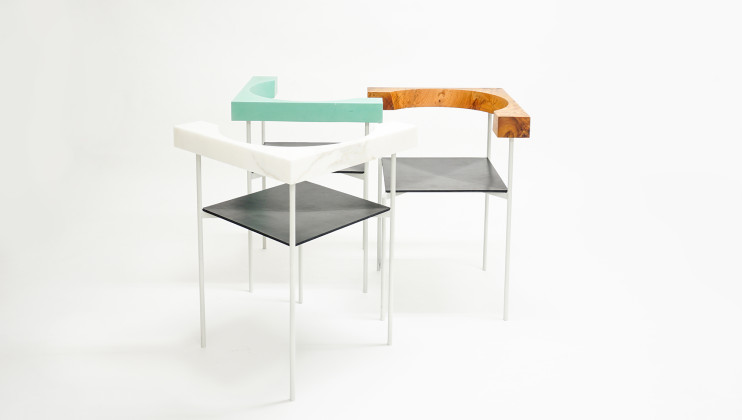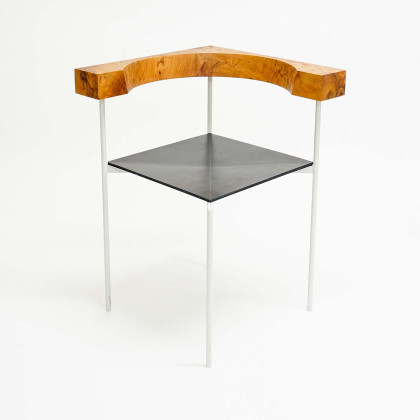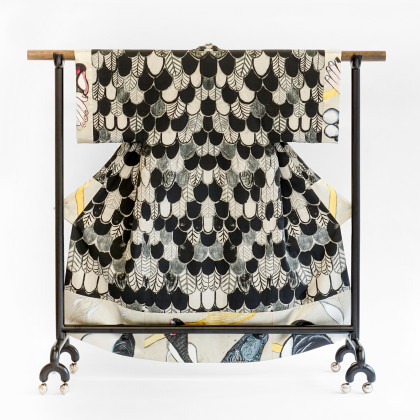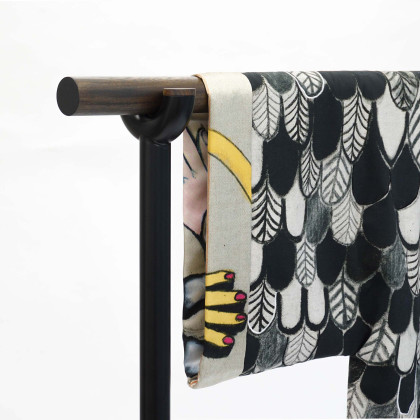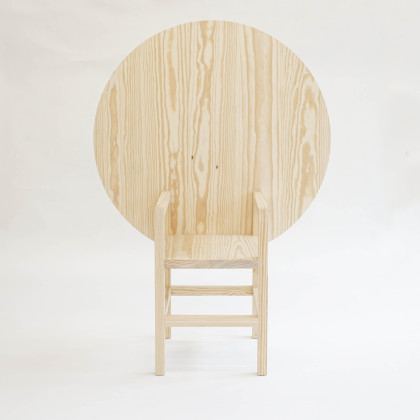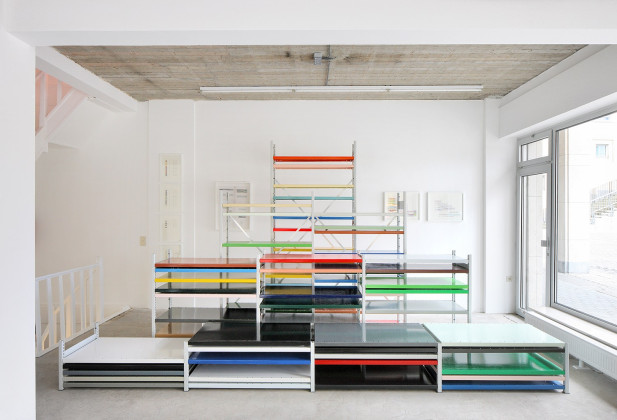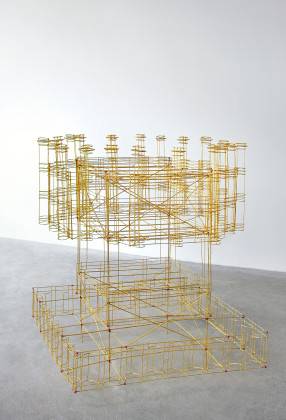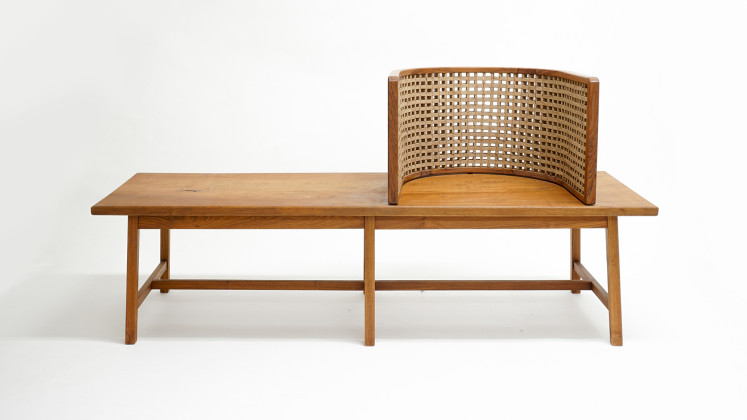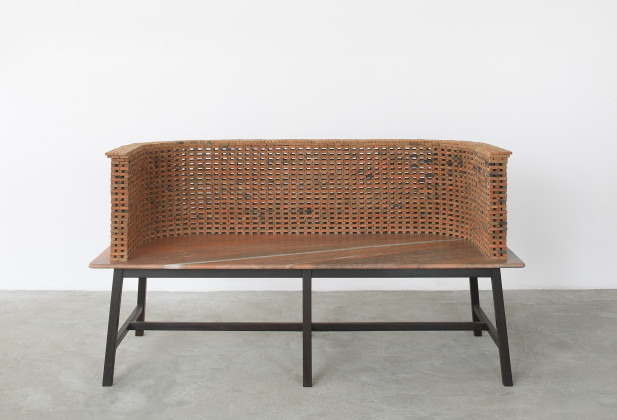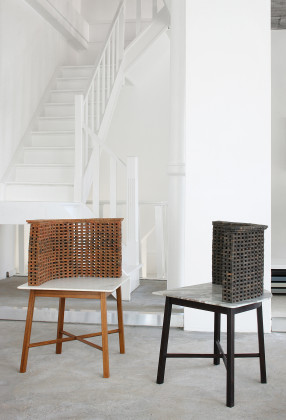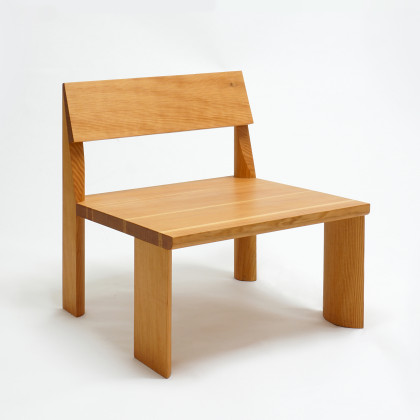In between Art and Architecture
Maniera searches new design proposals by working with architects and artists who blur boundaries between architecture, design and art
Maniera searches new design proposals by working with architects and artists who blur boundaries between architecture, design and art. Asli Cicek talks to the founders, Amaryllis Jacobs and Kwinten Lavigne, about the journey of the gallery, its collections and the way of processing.
Aslı Cicek: Maniera commissions architects and artists to design furniture. How was this idea born? Could you talk a bit about your respective backgrounds?
Amaryllis Jacobs: We have very different backgrounds. That’s the reason why it works well! I have been working for a long time in several big cultural institutions in Brussels, the longest period being for eight years at BOZAR, Centre for Fine Arts, where I discovered architecture. I come from a family that is deeply involved in music and doesn’t know anything about architecture. At BOZAR I also was the first assistant and head of communication for the music programme. But being there broadened my horizon because all arts are represented in BOZAR. When Paul Dujardin became the director of the institution he made me the head of the new education department for all disciplines. We worked closely with Art Basics for Children in Brussels. They introduce children in a very serious way into art but even more into architecture and design. This collaboration and the programme of BOZAR’s architecture department which made me discover and meet many relevant architects, opened my eyes and all of a sudden architecture became the center of everything! Around that time I met Kwinten who was engaged in the contemporary art- world and knew some architects as well. Through these encounters I fell in love with architecture and grew a profound interest in the work of architects with an interesting approach and a close relationship to the visual arts.
When I decided to do something on my own I also wanted to work with Kwinten who had been very important in the way I entered the art and architecture world. He had his artistic background and was working for a long time in art production while I came with lots of experience from coordination and communication. And together, we had an important network. We said let’s try to do something, combining architecture and art, involving production and communication.
Kwinten Lavigne: The idea for Maniera has its roots in these moments when we were searching for a good format to work with architecture and art. For a very short while there was an idea of founding an architecture center but after many years in art institutions, Amaryllis was fed up with going after public funding and institutions. We wanted to be completely independent. Thus came the idea of a gallery.
AJ: First we thought about an architecture gallery but this stipulated the sale of models, drawings etc. Very soon we realized, though, that architecture museums go directly to the architect and buy their production. There are many art collectors in Belgium, but very few architecture collectors.
KL: While developing the concept of the gallery, we also came to the conclusion that most of the relevant design objects were made by architects.
AJ: On the other hand, we (and Kwinten long before me) were very interested in the work of artists who play with the connections between art, architecture and design. Many significant artists created functional objects. Think of Donald Judd’s furniture, Rachel Whiteread’s daybeds, Franz West’s sofas, Ellsworth Kelly’s folding screens, Yves Kleins blue table, Rosemarie Trockels wallpapers… An ever greater number of artists today, refer to architecture and design in their work or use them as media. They flirt with the functional, with the thin line between sculpture and object.
KL: Since I had studied at the Academy for Fine Arts in Ghent (now KASK) and graduated with scenography concepts for theatre, I was very interested in things, everyday objects, which were telling a story. At that time I found it very intriguing that you can have a cupboard, which might tell a story. I made objects which could be furniture or raised questions about what they are.
AJ: The other way round, the artist’s approach is very stimulating to architects. For them, the source of inspiration is frequently found in art, in the sight of an unexpected image or object. We are particularly interested in those architects and artists that flirt with the boundaries between the fields of architecture and art. There is an almost sexual attraction between the disciplines. They strongly influence each other.
KL: The work of all the architects and artists we mentioned, a strong attraction to objects and a great desire to make and show things, inspired us to start Maniera. The concept of Maniera is very simple. We invite architects who have a close relationship to the visual arts and artists who are clearly inspired by architecture or design. Since most of the time they never did it before we guide them in the design process, help produce the pieces, exhibit and sell them in limited editions.
AC: How do you decide who to work with? Are there certain "curatorial" principles?
KL: We ask people a little bit through the gut feeling… But of course we are interested in professionals who in their own discipline already defined a set of principles about how they come to a form. They have a formula to approach their work. For instance Anne Holtrop uses the formal language of Hans Arp whereas Office Kersten Geers David Van Severen has a love for almost mathematical formalization of an idea. How the people we collaborate with define their own work fascinates us at the first place. Sometimes it can be a building, other times just a corner or a detail of it like in the case of 6A architects. There we were struck by a door handle they realized for the Raven Row Gallery.
AJ: Another important reason to work with 6A Architects was their book, “Never Modern”, about the role of narrative, history, appropriation and craft in their work. But we were also very conscious about the necessity to start at a certain level. We realized that starting Maniera in Belgium, where there are not many adventurous design collectors, and aiming to give complete carte blanche to our architects and artists was going to be quite risky. We got to the conclusion that we had to work with people who already had an international recognition. That way it became a calculated risk.
AC: Are you more interested in this aspect of recognition?
AJ: I’d rather say that the people we work with have a clear “Maniera” and that’s where the name comes from by the way. They speak a strong formal language and are great conceptual thinkers. Their method is defined so there is a base to start from, even if not yet translated into objects. Our first pieces were designed by Kersten Geers and David Van Severen, who were close friends, making great work and getting deserved attention. But when we invited them they first hesitated because we had no experience, we didn’t even have a gallery space. We were going to do the shows in our house. Eventually they agreed but with the condition to have a counterpart. So it was their idea to double it, to invite another party. I immediately came with Anne Holtrop. I had seen his “Trail House” in Z33 and was fascinated by it. His work was also completely opposite of what Office was doing. But there was a link between the two practices, they worked closely with the same photographer, Bas Princen. Office came up with the idea to ask Bas to curate the show since he had studied industrial design and was the only one who was trained more in the object world even if he chose not to practice that. This first became an example for the subsequent shows: all duo shows combining opposite or parallel practices.
AC: Were there some practices you had wished of working together before you even started with Maniera?
AJ: I always wanted to work with Bijoy Jain’s Studio Mumbai, clearly. It was almost obvious since they had already made lots of furniture and an incredible work emphasizing on craftsmanship. We paired that edition with Architecten De Vylder Vinck Taillieu because of a great lecture we attended. We were very much attracted by the drawings of the Belgian practice, which play an important role in their work. Jan De Vylder also talked around twenty minutes about their bricklayer and the importance of the masonry as well as the irreplaceable contribution of the craftsman in their projects. This convinced us that showing furniture work by Architecten De Vylder Vinck Taillieu next to objects created by Bijoy Jain would make a great exhibition.
AC: You have made already ten editions with different architects and artists, giving them carte blanche for their creations. How do you control the production process?
KL: The only clear condition we have is that we offer a fixed production budget. A furniture series, or a family of objects, needs to be produced within that budget. Some firms decide to enlarge that budget, but that is their decision. But I must say that our “carte blanche” commission is somewhat evolving. We now have more experience and know the market better, so I think we are guiding our artists and architects more than before. For us this is still work in progress. It is getting clearer and clearer what Maniera exactly is, how it exactly works, but we are still learning a lot.
AC: This experimental process is not only visible in the production but also in the content, perhaps most clearly in #10, Arbalette by the artist Valérie Mannaerts. She made only three pieces but one of them is a kimono, a drawing to wear so to speak, which requires a big interpretation to see the piece as furniture. You have to follow her story to perceive it that way, which indicated to me that Maniera never knows what might come out of the intentions…
AJ: Yes, but exactly this fascinates us, it is the reason why we like to do this. It is the charm of the unknown and also about meeting people we admire. We step into a project with them, a very long process sometimes. We are very curious people who like experimenting. But as I said earlier this is a calculated risk. We choose to work with people who already make very interesting work and we offer them an excursion from their usual practice. But knowing that practice very well, we are always convinced the outcome of the experiment will be exciting. The most important and most rational thing we have learned is that we should not produce nor show too many pieces. Together with our architects and artists we have to select the best proposals and produce them with the best craftsmen.
AC: This position you also somewhere different than the design art galleries such as David Gill in London or Galerie Kreo in Paris, who also work with architects or artists for furniture… They usually have very predictable shows if you know who is commissioned.
AJ: I think that each show we have done was very different from the other one. Our collection is very eclectic and our shows not predictable at all. Some of our objects are very functional, obvious design objects. Others are deliberate collisions between architecture, art and design. I must say we are attracted to both, but love to balance on the very fine line between the disciplines.
KL:At least it does not seem predictable to us. One might say that it is very obvious that we work with certain people. They are all in a way connected. The Belgian artist and architects I knew for a long time, from studying together or sharing friends, environments. The architects among them are constantly in contact with international colleagues who are of the same generation. They teach in the same universities, they exhibit in the same biennials… The vaguest step we took was perhaps with Bijoy Jain / Studio Mumbai because they are so far and we didn’t have direct connections to them. But it was a wonderful collaboration.
AC: Do you stay also open to less known or younger makers? There is also unpredictability in the work of less established people…
KL: No… I personally never had the intention of finding potential “stars” to work with. There are certainly interesting people who catch our attention but it will happen sooner that we work with an established office than a potential practice… This is also our commercial choice. The other fact is that Amaryllis and I don’t always have the same opinion about who to invite.
AJ: Yes, we do have lively discussions about the selection. Kwinten is definitely more involved in the artist projects.
AC: Do you like all the Maniera pieces?
AJ: A tricky question. I cannot say I am in love with all of them. I have my favorites.
KL: I like all pieces because I have a bond to them…
AC: Isn’t it also because you make them most of the time, at least the prototypes?
KL: Sometimes, not always. Some pieces I make, of others I follow the production. Bijoy Jain / Studio Mumbai, for instance, made all the pieces in their workshop with their own craftsmen. Other practices have their connections, contractors who I use for production or they contact themselves.
AC: Do you work more together with the artists then? I remember that you produced Richard Venlet’s chaise - longue…
KL: We offer production assistance to the people we work with. I have worked with many artists on production of their art works. It has been important in this start-up to be able to offer this experience to the people we invited. We also know that for the architects it is a very different thing. A project for Maniera is rather of small scale compared to other projects on their plate. What we can offer as help is hence the production or follow-up. Some practices use that service, others don’t.
AC: Do you see recurring differences between the methods of artists and architects after ten editions, concerning production?
AJ: There are huge differences. For the last two editions Valérie and Sophie dived into the commission well in advance. Many architects we worked with delivered in the very last minute. In the case of artists we enjoy almost a luxury because they commit themselves to the project more continuously.
AC: Are architects also more used to outsource the work to be finished?
AJ: Not all of them. Tom Emerson and Stephanie Macdonald of 6a made the first Dust Free Friends themselves at home. It was their very consequent choice since their project is based upon Enzo Mari’s reproducible furniture. Bijoy Jain spent a whole intense month with his big team of architects and carpenters trying out many things. He did not draw any plan. He made the pieces and adapted them little by little until he was completely satisfied. Atypically, Anne Holtrop sewed the wooden panels for his stony objects himself in his studio. Architecten De Vylder Vinck Taillieu also worked very hard towards the end with a team of collaborators and architects. At the time of Maniera edition the studio was also working on their project for the Venice Biennial. The pieces for the Belgian pavilion and for Maniera were made simultaneously by the same people, in the same workshop. We were very proud of that!
AC: From outside it looks like all going well with the gallery, which is probably a very romantic view of the reality…
AJ: Of course some projects were less successful than others. But we are very lucky that there is a good balance. Some editions work very well, others less. Meanwhile we know which one works better yet this doesn't mean that we don’t want to do the riskier ones anymore. The carte blanche and experimental aspect remain important nevertheless. But there is the reality of the figures and we have to keep the balance because we want to keep on doing this for a very long time.
KL: Lately I think a lot about the theory of “needed action”. If a stone breaks free from the ceiling, you might wait as long as possible but eventually you move your body to escape it. This action is happening also with Maniera. But I also read an interesting article about people who constantly plan seem to die earlier because they are continuously stressed…Through my previous experiences I developed a trust that there will always be a solution. In the end there are more solutions than problems. We trust our gut feeling and believe in the people we invite. We lead them gently sometimes towards a direction but try not to overdo that.
AC: But with your choices in Maniera you make curatorial statements, don’t you? The editions #09 and #10 are by two female artists, which can be read immediately as a statement as well.
AJ: In a way that’s the only thing we do, we choose the right practices to work with. The choice of showing two artists, Valérie Mannaerts and Sophie Nys in one exhibition space, didn’t come as directly as in other cases. But we were considering to work with them for a long time and saw that actually parallel editions with them would be very complimentary. But our decision was not colored by the fact that they are both female artists. This came as a natural consequence of seeing the potential of showing the works parallel.
AC: You held the first shows in the domestic environment of your house. Two others you organized in the houses built by Henry Van de Velde and Juliaan Lampens accommodated the pieces also in a more natural way. Since April 2016 you have a gallery space in Brussels. Did this have an effect on how you are received?
AJ: In the beginning we didn’t have any costs for a permanent exhibition space. This was perfect to start at a slow pace. But it was also for a limited group of people and we needed more visibility. Having a gallery space changes the rhythm. We have to keep that space alive and that results in more editions per year.
KL: We liked to do the shows in our house but the gallery gives more visibility. To me it is a storage place with a big vitrine. When we made the shows in our own home people had to call us to make an appointment, which is a barrier. Nevertheless, we still like to hold shows in existing houses. We will keep on doing that, yet only when it makes sense, as in the two cases until now. Richard Venlet had proposed to show in House Wolfers, relating his pieces to the house. By doing a residency in a Lampens house, Jonathan Muecke truly entered into a very rich dialogue with Juliaan’s furniture and architecture in the show we did in the Van Wassenhove House.
AC: Maniera was also very quickly invited to international design fairs. Do you like these environments since they are usually very big and might, in my opinion, contradict with your ideas about editions, exclusiveness, even a certain intimacy perhaps, growing out of the close collaboration with the artists, architects?
AJ: We were very lucky to be invited quite quickly by Design Miami, one of the most prestigious fairs in the collectible design world. It is very difficult to get into that fair but only one week after the first opening in our own house we received an invitation from the artistic director of the fair to come and discover the next edition in Basel. We participated twice so far. Design Miami Basel has been extremely important for us. It mainly brought us credibility. We met people we needed to meet, for networking it is incredibly important. Collectors, collection representatives, important curators, interior architects, etc. are present. To continue with Maniera we have to expand our network in the world of collectible design. We are not interested in serial production but in experiments. We develop one prototype for our shows and then produce upon demand. This means we produce pieces one by one, with the help of very good craftsmen, using the best materials. As a consequence our pieces are quite expensive. The only feasible business model for us is to make the editions exclusive and to go to these fairs to show them, generating orders.
KL: We now also have been selected for Art Brussels, which is very special because it is an art fair. But we are not always sure how to deal with these invitations. It is tempting to do this but it is also quite frightening since we are not an art gallery. The big fair surrounding is not easy for us. We heavily evaluate which fairs we want to be part of as we are rather radical if I see the neighboring stands. Design Miami changed our position but we still feel a bit strange in that environment, which would not be different in art fairs either. We represent neither design, nor art – nor architecture for that matter – fully. That is what Maniera is, in the end.
 25.01.2017
25.01.2017



